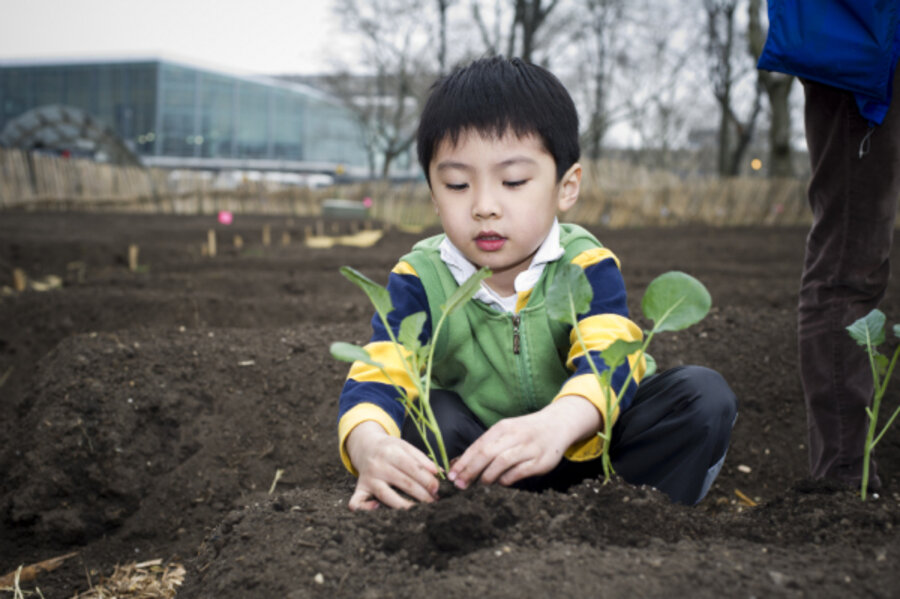Do urban farms reduce runoff and save water? Seeing Green is finding out
Loading...
In cities all over the United States, urban agriculture has joined the farmer’s market as an accessible, even trendy, way for city dwellers to assert their commitment to living sustainably. But despite the individual benefits from eating healthy, organic produce, it’s hard to see – and measure – the social and environmental impact of urban farms.
Rooftop farms may seem like mere Band-Aids in overcrowded cities marked by unequal distribution of healthy food. But two environmental scientists are determined to prove that urban farms have a multifaceted positive effect in a cityscape, and that urban agriculture deserves recognition as a viable means toward creating a more sustainable and equitable urban ecosystem.
Seeing Green is a year-long research project that will measure the stormwater management potential of urban farms. The founders hope the final data can prove that urban farms greatly mitigate escalating waste management problems in cities, giving scientific fodder for policymakers to support the burgeoning urban agriculture movement.
Dowser: Tell me about how you realized that this research was needed.
Tyler Caruso, project co-director: I ran my own sustainable landscaping company in San Francisco for a couple years and did a lot of "gray water" work. Gray water is any water in a house other than your toilet – from your shower, hand faucets, and so on. It’s not potable but it can be recycled to water your plants or wash your car. So I moved back east to go do my M.S. at Pratt and started doing more gray water work. It surprised me how much urban agriculture there was in New York City. But I also saw that urban agriculture was happening without a lot of city support; these farmers were just making it happen on their own.
What do you think is the reason for that lack of city support for urban agriculture?
People talk about the benefits of urban agriculture, but it seems that we don’t really know how to articulate those benefits and put them into policy. Right now the city’s Department of Environmental Protection is unrolling a green infrastructure plan. This is basically a movement away from mechanical, industrial ways of treating our stormwater supply. Planting trees, bioswales, blue roofs – all these are in the plan. But there’s no mention of urban agriculture. And my research partner Erik [Facteau] and I saw this as a huge disconnect. One of the reasons for that is there are no metrics for measuring the impact of green roofs.
So, your project aims to create that metric and then supply it to city programs?
With metrics you can monetize the benefits of green infrastructure. Urban farms absorb and retain rainwater, but we have yet to measure just how much they are capable of retaining. If you put a green roof anywhere, not only does that stormwater never reach a wastewater treatment plan, not only are you decreasing the monetary cost, but you’re using less electricity too. Seventeen percent of our greenhouse gas emissions are from wastewater treatment plans.
People in city offices need numbers, they need metrics. There’s a lagging in scientific study right now. Metrics for green roofs exist but not for urban agriculture. We thought that creating this research would be a great way to support urban agriculture, and show that it is a viable part of a city’s green infrastructure.
Why is green infrastructure such a priority right now?
There are systemic problems with [New York City’s] wastewater system. The pipes were designed to prevent flooding; they weren’t made to handle both septic waste and stormwater waste. So when it rains a lot, the treatment plants get overwhelmed and they discharge raw, untreated septic waste into our water bodies. There are 422 combined sewage pipe holes where this water discharges any time the plants reach capacity. Awareness of CSO – combined sewage overflow – is growing. There’s this video on YouTube of septic waste overflowing into the Gowanus Canal.
Anytime you increase the green infrastructure of a city you’re decreasing CSO because you’re buying time and space for the stormwater to infiltrate the ground and get absorbed. So we want to show how much these farms are capable of and get policymakers’ attention. To the best of our knowledge there have been no studies like this.
One thing that struck me is that you’re doing this scientific research using funding from a Kickstarter campaign. Why not use grants?
So much of the farming community right now is about helping each other, and also we wanted to avoid having an attachment to an institution. We want this research to reach everyone and be replicated on a community, grass-roots level – it should belong to the people, belong to the farmers and the supporters. This is citizen science.
What’s your plan for publicizing the information and getting it to policy makers?
The research will take a year because we want to look at an entire growing season. We know people who work for city council members. Speaker Christine Quinn right now is looking to do a green roof amendment – right now it’s not possible to grow food-producing plants on green roofs, it’s a hole in the legislation and she wants to amend that. So we want to present our research to Speaker Quinn as a companion piece. Whomever’s the next mayor, we want to get this information into the next PlaNYC, the city’s plan for sustainability.
Interview has been edited and condensed.
(This story originally appeared on DOWSER.ORG, along with a video about Seeing Green.)





